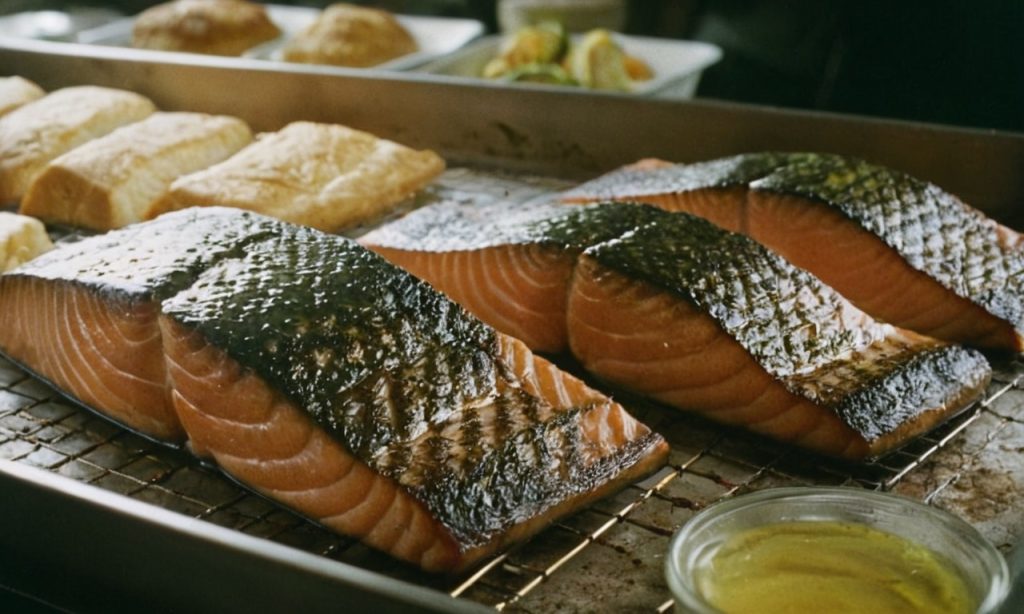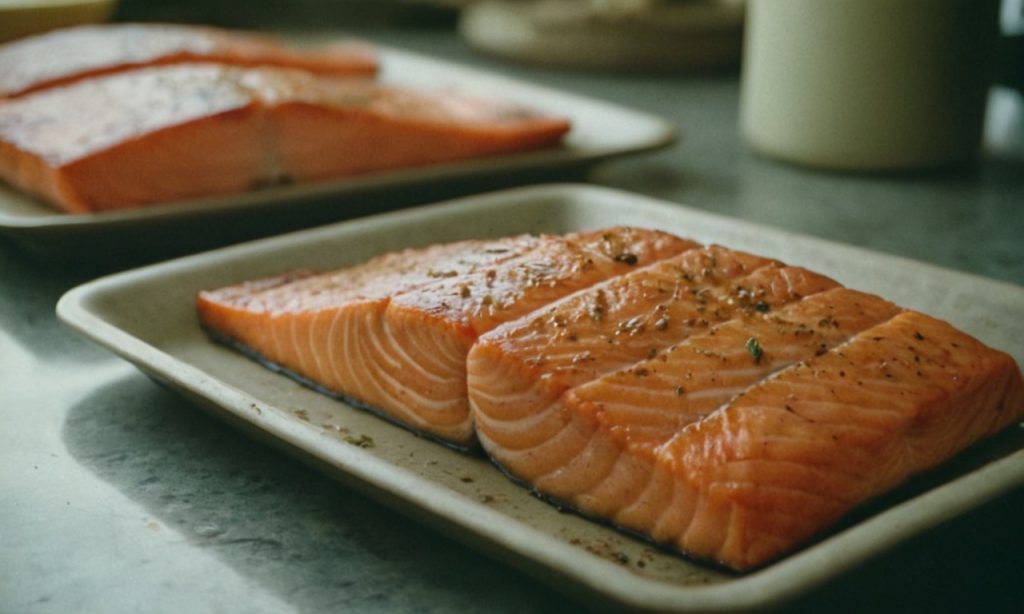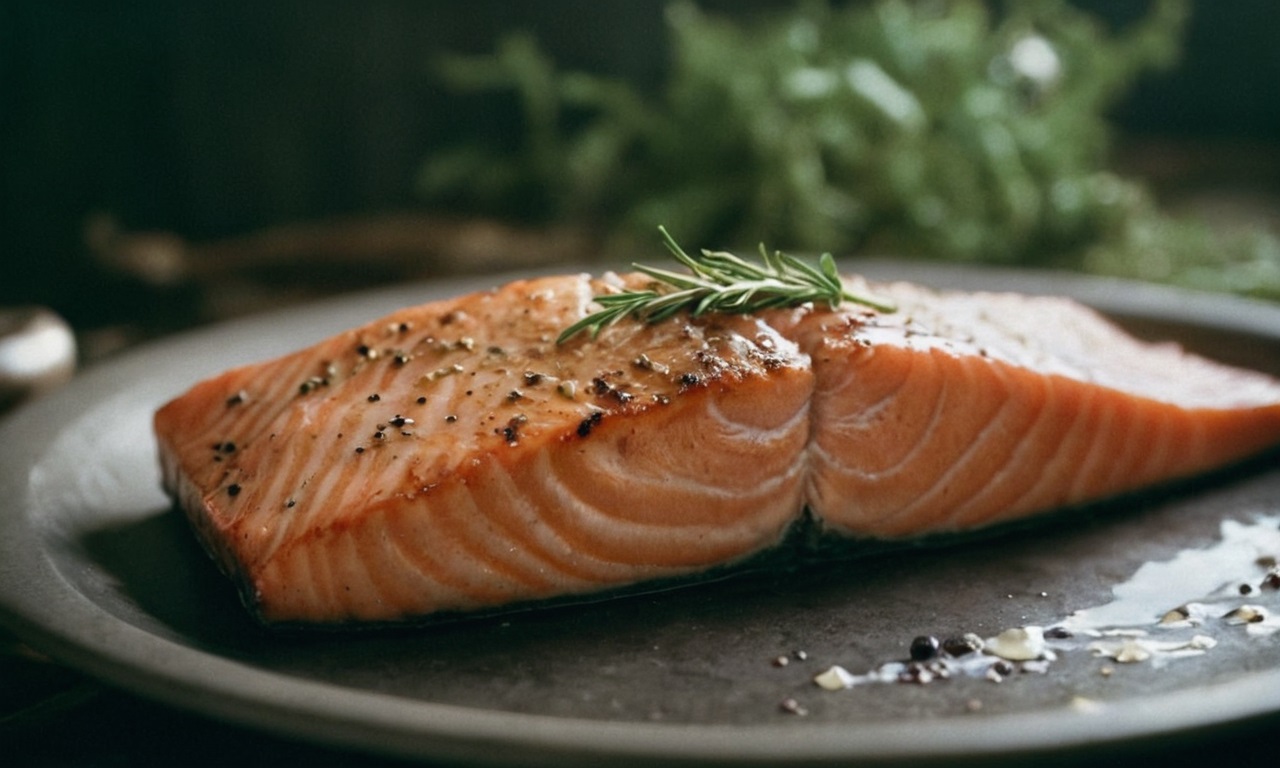Baking the perfect salmon doesn’t have to be a culinary mystery. With the right technique, achieving that flaky, tender, and flavorful outcome every time you pop a salmon fillet in the oven can be a breeze. Whether you’re a seasoned chef or a kitchen newbie, this guide on how long to bake salmon at 400°F is your ticket to a delicious, heart-healthy meal that’s both quick and easy to prepare. Let’s dive into the world of oven-baked salmon, exploring not just the optimal baking times but also the little tricks that make all the difference. From selecting the best cut to the final touches that elevate your dish, we’re covering it all. So, preheat your ovens and let’s get started!
Introduction to Baking Salmon

Selecting the Right Salmon
Picking the right type of salmon is the first step to a mouthwatering meal. Look for Sockeye, Coho, or Chinook salmon varieties, which are known for their rich flavor and tender textures. When shopping, aim for freshness; the fish should have a bright color, firm flesh, and a clean smell.
Preparation Basics
Before the salmon hits the oven, a little prep work is needed. Start by giving your salmon fillet a good rinse under cold water and pat it dry with paper towels. This ensures even cooking and a nice crust. Next, let’s talk about the canvas of flavor – the seasoning. A light drizzle of olive oil, a generous sprinkle of salt and pepper, and your choice of herbs can transform your salmon from mundane to magnificent. Feel free to get creative here; a dash of garlic powder, a sprinkle of crushed herbs, or even a thin layer of brown sugar for a caramelized finish can make all the difference.
Stay tuned for the next part where we’ll delve into the heart of the process – the baking! With the right prep and a keen eye on the clock, you’re well on your way to a perfectly baked salmon that’s sure to impress.
Baking the Salmon
Step-by-Step Baking Guide
Now that your salmon is prepped and ready, it’s time to get baking. First things first, preheat your oven to 400°F. This optimal temperature is key for a perfect bake. While the oven warms up, line your baking tray with parchment paper or aluminum foil for an easy cleanup later. Lay your seasoned salmon skin-side down (if it has skin) on the tray. This not only prevents sticking but also allows the skin to become wonderfully crisp.
As the oven reaches the right temperature, slide your tray in and let the magic happen. Here’s where patience plays a role. Resist the urge to keep checking; every time you open the oven door, you’re letting out precious heat, making it crucial to maintain consistent heat.
Determining the Cooking Time
The thickness of your salmon fillet dictates how long it should bake. A good rule of thumb is 10-15 minutes per inch of thickness. So, whip out that measuring tape or eyeball it if you’re feeling confident. Remember, it’s better to err on the side of caution and check your salmon a bit earlier than the estimated time. Overcooked salmon is a no-go, as it loses its delightful tenderness and moisture.
The moment of truth comes when you check for doneness. The salmon should flake easily with a fork and have a slightly translucent center. If you’re into gadgets, an instant-read thermometer should read 145°F when inserted into the thickest part of the fillet.
Baking salmon is like conducting an orchestra; every element needs to be in harmony. But with these steps, you’re set to create a masterpiece. Next up, we’ll explore how to ensure your salmon is just right, every single time. Stay tuned!
Ensuring Perfect Doneness
Achieving that ideal point where your salmon is just cooked through, yet still moist and flaky, is an art. But fear not, for it’s an art that can be mastered with a few pointers.
Checking for Doneness
The visual and tactile cues are your best friends here. Look for the moment when the salmon changes from translucent to opaque, a clear sign it’s about ready. Gently pressing on the top of the fillet should yield slightly to the touch, indicating it’s just right. If it feels firm, you might be veering into overcooked territory.
Using an instant-read thermometer can take the guesswork out of this process. Aim for an internal temperature of 145°F, but remember, the salmon will continue to cook a bit even after it’s out of the oven, thanks to residual heat. This is what chefs call “carryover cooking,” so it’s wise to pull it out just shy of the target temperature.
Common Mistakes to Avoid
It’s easy to fall into the trap of leaving the salmon in the oven “just a bit longer,” but resist the temptation. Overcooking is the quickest route to dry, lackluster fish. On the flip side, under-seasoning can leave your salmon tasting bland, while over-marinating, especially with acidic ingredients, can start “cooking” the fish before it even hits the oven, affecting its texture.
Remember, the perfect piece of baked salmon should feel like a celebration on your palate, bursting with moisture and flavors that sing in harmony. Up next, we’ll delve into how to round off this symphony with the perfect accompaniments and presentation tips. Stay tuned for a feast for the senses in Part 4!
Serving and Pairing

Once your salmon has reached its peak of perfection in the oven, it’s time to think about how to turn it into a complete, mouth-watering meal. The right sides and a little flair in presentation can elevate your baked salmon from a simple dish to a culinary delight.
Side Dishes and Accompaniments
The best companions for your oven-baked salmon are those that complement its rich, tender flavors without overpowering it. Think of a bed of fluffy quinoa or a side of roasted asparagus. For a touch of comfort, a creamy mashed potato works wonders, while a bright, citrusy salad adds a refreshing contrast.
Remember, balance is key. You want sides that will enhance the salmon’s natural flavors, not compete with them. A drizzle of a simple lemon-herb sauce or a dollop of dill-infused yogurt can add an extra dimension to the dish.
Plating and Presentation Tips
The visual appeal of your dish plays a huge role in the overall dining experience. Start with a clean, simple plate that lets the salmon shine. Position your salmon fillet at the center, and artfully arrange your sides around it, ensuring a variety of colors and textures are on display.
A sprinkle of finely chopped herbs or a few edible flowers can add a touch of elegance to your presentation. Remember, we eat with our eyes first, so taking a moment to thoughtfully plate your dish can turn a simple dinner into a special occasion.
With the salmon perfectly baked and beautifully presented alongside delightful sides, you’re all set to impress at the dinner table. But why stop there? In the next part, we’ll explore some advanced tips and variations to keep your salmon repertoire exciting and endlessly delicious. Stay tuned for Part 5, where creativity meets culinary expertise!
Advanced Tips and Variations
After mastering the basics of baking salmon to perfection, it’s time to experiment and elevate your dish with some advanced culinary tips and creative variations. Let’s dive in and add some flair to your salmon repertoire!
Flavor Variations
One of the joys of cooking salmon is its versatility when it comes to flavors. Don’t hesitate to explore beyond the traditional seasonings. How about a spicy salmon rub for some heat, or a maple-glazed topping for a sweet and savory twist? Introducing different herbs like fresh dill, cilantro, or even a sprinkle of smoked paprika can dramatically change the profile of your dish, making each bite a new experience.
For those who enjoy a bit of crunch, adding a crust to your salmon can be a game-changer. A mixture of breadcrumbs, parmesan, and herbs, lightly patted onto the salmon before baking, creates a delightful contrast between the crisp exterior and the tender, flaky interior.
Alternative Cooking Methods
While oven-baking is a foolproof method for salmon, don’t shy away from experimenting with other cooking techniques. Slow-roasting at a lower temperature can yield incredibly tender results, while grilling adds a smoky depth of flavor that’s hard to resist. Air frying, on the other hand, offers a quick and slightly crispier alternative, perfect for those busy weeknights.
Each method brings out a different quality in the salmon, from the juiciness of slow-roasting to the charred edges from grilling. The key is to understand the nuances of each technique and how they interact with the natural flavors and textures of the salmon.
With these advanced tips and variations, you’re not just cooking salmon; you’re crafting an experience. Each dish becomes a canvas for your culinary creativity, inviting you to play with flavors, textures, and techniques. Stay tuned for the final part of our guide, where we’ll tackle the most common questions surrounding baking salmon, ensuring you’re equipped with all the knowledge you need for flawless results every time.
FAQs Section
In our journey through the art of baking salmon, we’ve covered a wide range of tips and techniques. Now, let’s address some of the most commonly asked questions to clear up any lingering uncertainties and ensure your next salmon dish is nothing short of spectacular.
Frequently Asked Questions
- How do I store leftover baked salmon?
Leftover salmon should be cooled to room temperature as quickly as possible and then stored in an airtight container in the refrigerator. It’s best enjoyed within 1-2 days. - Can I reheat baked salmon?
Yes, but the key is to do so gently to avoid drying it out. Reheat it in the oven, covered, at a low temperature, or gently microwave it with a splash of water. - What’s the best way to ensure my salmon is moist?
Avoid overcooking by using a thermometer and removing the salmon from the oven just before it reaches the desired temperature. It will continue to cook slightly from residual heat. - How can I make my baked salmon more flavorful?
Experiment with marinades and rubs before baking. Even simple additions like lemon, herbs, and spices can significantly enhance the flavor. - Is it necessary to remove the skin before baking?
Not at all. Baking salmon with the skin on can help retain moisture. Plus, some people enjoy the skin when it’s crisped up.
By addressing these FAQs, we hope to have resolved any doubts and inspired confidence in your salmon-baking endeavors. Remember, cooking is as much about intuition and personal preference as it is about following recipes. Don’t be afraid to experiment and adjust based on your tastes and the ingredients you have on hand.
With this comprehensive guide, from selecting the perfect fillet to serving it up with style, you’re now fully equipped to master the art of baking salmon at 400°F. Here’s to many delightful dinners ahead!

